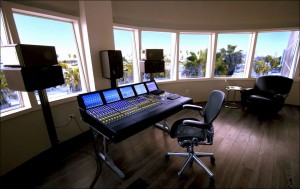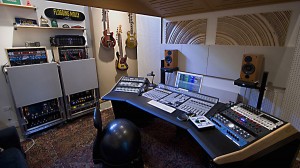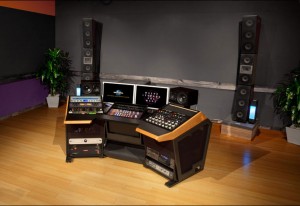Delta H Designs ZR Acoustics: Removing The Room From The Room
Delta H Designs Inc. is an architectural acoustics design firm founded in 1997 by Hanson Hsu. They specialize in the design of recording/mastering rooms, post production, broadcast and other audio specific environments. When Delta H developed their trademarked Zero Reflection (ZR) technology in 2006 (ZR Acoustics®), the audio world really began to take notice. I sat down with Delta H Principal Hanson Hsu a few weeks ago in a room he designed – Universal Mastering Studio B – to discuss acoustics and the trademarked ZR technology that has made his room designs sound so good.
When I began corresponding with Delta H Designs (DHDI) founder Hanson Hsu about setting up a chat, he always ended his emails with, “Make sure you bring some CD’s with you…” After digging through a few old boxes for some CDR’s I finally found a few and was off!
On the day of our interview at Universal Mastering’s Studio B, the first thing we did was spend some time listening to an album I had mixed and had mastered the previous week. Listening to anything on a giant pair of Lipinski monitors is a great experience virtually anywhere, but I was blown away by one thing in particular here: No matter where I stood in the room – and I do mean anywhere – everything sounded exactly the same.
The most stunning thing of all was that the room itself was just a rectangular box – no bass traps, panels, or diffusors to be seen. Suspension of disbelief is hard in a situation like that, and I assumed that there had to be some kind of hidden trapping system or resonators hidden in the design, but the truth was that it was all due to Delta H’s ZR technology incorporated into the walls and ceiling.
In the case of the Universal Mastering’s rooms, the ZR treatment and the actual walls are part of an integrated whole, the outer section of the walls are designed to provide isolation, and the signature component contains the ZR elements which create the “sound” of the room, or as Hanson refers to it, the room’s “acoustic signature”.
Hsu made his breakthrough with ZR when he was contracted to build a mix room for mixer Mike Shipley (AC/DC, Maroon 5, Def Leppard, etc.) in 2006: “Mike had changed his paradigm, and wanted to stay in one place where he could mix all day and all night,” Hsu describes. “He was getting a [Digidesign] Icon, one of the first in LA. He told me: ‘You can’t do a room within the room, you can’t angle the walls, and I want to use every square inch of what I have. Go.’
“So after freaking out for about a day thinking there was no way to do this, my science mind kicked in and I made a list: let’s take all the good and bad things about control rooms and figure out what causes them. We finally came up with a concept that spec’d out, so I went to Shipley and said ‘I have a plan. According to my research this should work, but it’s also never been done before, so if you’re game, I’m game.’ It ended up working phenomenally better than we expected.”
THOUSANDS OF NON-PARALLEL SURFACES
Flying high from the success of the experiment in Shipley’s mix room, Delta H Designs then spent a lot of time testing the room, figuring out why the design was so much more successful then they had predicted, and began refining the technology with each project they took on from that point.
What makes ZR technology so effective is a trade secret, and Hsu even concedes that they are still developing the proper tools to adequately measure its effects, as they currently do not exist. From what I was able to glean though, ZR works off of a contemporary take on eliminating parallel surfaces in a room, however, it does it on a micro scale: Each ZR surface contains thousands of tiny non-parallel surfaces, which has a broadband effect on sculpting sound waves and their harmonics.

The audio post facility, Kill The Messenger Studios, in Santa Monica features the world’s first semicircular glass ZR Acoustics® Virtuoso room
“The way we are creating acoustic signature is through extremely high acoustical resolution mixed with creative intuition,” he explains. “Many many many many non-parallel surfaces at very specific angles, directions, with specific designs – and with very specific materials – ubiquitous materials. You can’t just say we’ll put in a lot of non-parallel surfaces and call it acoustical design. There’s a lot of creativity to it. There’s a lot of math to it.”
Because these non-parallel surfaces are so small, the treatment can be very thin, and has been getting thinner with every ZR iteration and application. Delta H uses the term “acoustic resolution” to describe the number of non-parallel surfaces per square foot, and measures their latest offering (ZR Micro Panels) as having over 14,000 times the resolution of a traditionally designed control room per square foot, and that’s in a single two-foot square panel.
It’s pretty hard to wrap your head around, especially when you hear the results, and as Hsu said to that effect: “As a culture we’re fine with reducing the size of electronic devices smaller and smaller, however, we aren’t fine changing the really funky, cool, trapezoidal, architectural studio that we love and know, even though it would sound better. We decided to challenge that premise and do something new.
“Those older theories allow for a one foot square sweet spot, enormous bass build up in the corners and considerable losses in usable footage that also requires EQ for the whole room.”
There is no question of the validity of Hsu’s point, and the proof is in the pudding, especially when you stand in the back corners of a ZR room and hear barely a 1 dB build-up in bass frequencies.
AN ADVANCE IN HOME STUDIO ACOUSTICS
While ZR Technology represents a great step forward in the design of professional listening environments, it seems that that where it could really shine is in the world of the DAW-based home studio. In fact, it seems quite analogous to it, representing an architectural advance that perfectly echoes the reduction in cost and footprint of the DAW itself. To so many of us working in smaller rooms or out of our homes, a low impact and cost-effective acoustical solution has a ton of appeal; for some, affordable ZR products could mean the difference between acoustically treating your room, or not.
With minimal modification to an existing space, ZR Custom Designs can be incorporated into virtually any room and the aural effects can radically improve its character – that is to say that it virtually eliminates it. It should be noted here, that while ZR products creates the acoustic signature, it does not provide actual sound isolation, a prospect which represents an additional aspect of the design (for more on that, read Justin Colletti’s article, Soundproofing the Small Studio).

ZR Micro and ZR Sample Rate 8 Bit panels were used in the acoustic design of producer/engineer Ryan Hewitt’s private studio in Venice.
The big news at DHDI this year was announced last month at the AES show in San Francisco: ZR Technology is now being made available through a variety of product lines that are scaled to the needs and budgets of virtually any level of professional who wants a neutral and perfectly balanced room.
On the more affordable end of the spectrum, Delta H is offering the ZR Prefab, ZR Micro, and ZR Sample Rate 8 Bit lines; offering panels which can easily be affixed to walls, and because they are of the latest and greatest design, offer performance which exceeds that of the first ZR materials designed for Mike Shipley’s original room.
In the case of ZR Prefab, a more complete and comprehensive solution is offered, as the panels are custom designed for the space. On the higher end, for those users looking for a custom design experience, DHDI will of course design a room from the ground up, or an extensive retrofit of an existing space – the major advantage of course being that room-within-a-room design is unnecessary, greatly reducing the amount of construction necessary.
Perhaps the most interesting product introduced at AES is the ZR Nomad, a studio ensconced within either a 20- or 40-foot long shipping container. While not the most applicable to many of us, the ZR Nomad makes a lot of sense to users in remote areas or even on studio lots, and of course, ZR technology helps make that rectangular box sound amazing.
While it may seem hard to let go of the radical studio design concepts of the past, and many of them are quite successful in their sound and execution, I believe Zero Reflection technology bears serious consideration moving forward. There is a definite sense of relief one gets from the elegant minimalism of design in a ZR room.
While the brute force control of a more traditional control room environment can be exciting to behold, it suddenly seems unnecessary and even burdensome in relation to the future possibilities of acoustical design by Delta H Designs / DHDI.
For more information on Delta H Designs and Hanson Hsu, visit http://www.deltahdesign.com.
Bo Boddie is a Grammy winning engineer/producer and composer. Visit him at http://www.boboddie.com.
Please note: When you buy products through links on this page, we may earn an affiliate commission.








Andrea Marino Zavareei
December 13, 2012 at 11:18 am (12 years ago)This is amazing stuff.